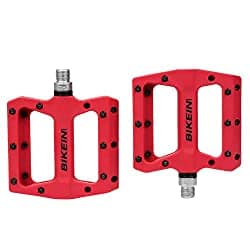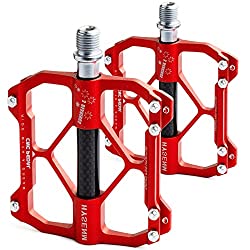The market has sundry BMX pedals, making it hard to choose the right one. While pedal material, price, and brand are important, nothing is more important than getting the pedal size correctly. So, what size are BMX pedals?
Ideally, BMX pedals come with a 1/2-inch-wide spindle thread diameter, also known as the screw thread size, often expressed as 1/2 x 20 TPI. However, modern adult BMX bikes are compatible with 9/16-inch pedals, often considered standard-size pedals.
By looking at the crank, you can tell if your old BMX pedals are a size 1/2 inch or 9/16 inches. If it is a one-piece crank, the pedal spindle thread diameter is 1/2 inch. But if it’s 2-piece or 3-piece, then it’s 9/16-inch.
Don’t worry, as I will explain how to go about it in detail. I’ll even share other ways to determine your BMX pedals size and a quick buying guide for the best BMX pedals.
But first, let’s differentiate 1/2-inch and 9/16-inch BMX pedals.

What Size Are BMX Pedals? 1/2-inch vs. 9/16 inch
As hinted, we’ve two major types of pedals, 1/2-inch and 9/16-inch. The two are categorized depending on the spindle thickness or diameter, but they have the same tire quality casing of 20 TPI.
Let’s see what to expect from each;
1/2 Pedals BMX
The 1/2-inch pedal is widespread on BMX bikes, kids’ bikes, and some vintage cruisers. Sadly, their pedals are not as common as the 9/16 inch options, which means you may have a hard time finding their exact replacement.
Ideally, 1/2 inch pedals are compatible with a one-piece crank which means you can know if you have 1/2 inch pedals if the BMX crank is one-piece. 1/2 inch pedals also go by the measurements 0.50″ x 20 TPI.
9/16 BMX Pedals
9/16 inch pedals have thicker spindles and are compatible with 2-piece or 3-piece crank. So, if your bike has a 2-piece or 3-piece crank, you need to get 9/16-inch pedals.
Luckily, these pedals are common on the market as they are the modern style. They are compatible with modern BMX bikes and with every other adult bike.
The SE Bear Trap BMX Pedals and 25 NINE Ronin Platform BMX Pedals (View on Amazon) are good recommendations.
They are both compatible with 3-piece BMX cranks. The only difference is that the SE Bear Trap BMX Pedals come in an aluminum alloy build, thus more durable than 25 NINE Ronin BMX Pedals, whose body is polypropylene.
25NINE Ronin BMX Pedals are lighter, thus suitable for racing BMX bikes. 9/16 pedals also go by the measurements 0.56 x 20TPI.

The Forgotten Bike Pedal Size – The 0.55″ Old French Pedal
In addition to the 1/2″ x 20 TPI and 9/16 x 20 TPI pedals, we have the 0.55″ x 20.32 TPI pedals. These pedals are an old French style that is no longer made. You may find them on old French bikes.
Summary
With the above information in mind, here’s how the three pedals compare:
| BMX Pedal Size | Crank Type | Bike |
| 1/2” x 20 TPI (12.7mm x 1.27mm) | One-piece crank | BMX, kids, and old beach cruisers |
| 9/16” x 20 TPI (14.28mm x 1.27mm) | Three-piece crank | Modern bikes |
| 0.55” x 20.32 TPI (14mm x 125mm) | Old French bikes |
How Do I Know What Size BMX Pedal I Need? A Quick Guide!
Since there are different types of pedals, it’s essential to know what size to go for. Here are the tips for applying:
a) Identify The Crank Type
Remember, a one-piece crank is compatible with a 1/2 inch BMX pedal, while a two-piece or three-piece is compatible with a 9/16-inch pedal.
In that case, you’ve to determine the crank type on your bike. If the crank is one uniform piece, it’s a one-piece crank, but if it features two or three different sections, it’s a 2-piece or three-piece.
b) Measure The Pedal Thread Width
If you don’t mind doing a bit of work, consider measuring the thickness of the pedal thread. That’ll help you know what size pedal to get.
If the pedal thread is 1/2 inch (0.50 inch) wide, you should get BMX Pedals 1/2. But if the width is 0.56 inches, you have a three-piece crank, which means you should get 9/16-inch pedals for the bike.
Remember to use a thread and ruler to measure the pedal thread width.
c) Ask The Manufacturer
There is no better person to inquire about the pedal size than the manufacturer. You can contact the bike or pedal manufacturer to ask about the size and the best replacement. They’ll make the best recommendation to serve you longer and more efficiently.
d) Talk To A Local Bike Mechanic
Local bike mechanics usually are familiar with the various bike pedals. So, you can take your bike there to inquire about the size.
The chances are that you’ll find the matching replacement pedals in their repair shops. But overall, it’s up to you to decide whom to buy from.
Other Buying Considerations for BMX Pedals
While getting the BMX pedal size correct is paramount, it’s not the only consideration when shopping for BMX pedals. You also have to consider the following:
(a) Pedal Type
Usually, BMX pedals come in two types: flat/platform and clip. Overall, platform pedals are the most popular choice because they offer a wider surface for the feet to rest on and are generally sturdier.
Their only issue is that they don’t allow you to focus the foot pressure in a manner that promotes acceleration. So, they aren’t the best for racing BMX bikes but are more suited to performing stunts.
If you want to accelerate more and perform fewer stunts, the pedals to go for are clip options. Clip pedals are generally the easiest to install and are more beginner-friendly. They are, however, less sturdy than the platform.
(b) Material Type
Most BMX pedals come in plastic, aluminum, steel, and nylon options. Nylon resists weather elements better and is more colorful, while plastic offers the cheapest options.
On the other hand, aluminum alloy pedals are more rigid and lightweight (though not as plastic), while steel pedals are the most durable.
So, you’ve to decide what matters most to you. But if you cannot compromise, then go for aluminum, and one pedal that won’t disappoint is the SE Bear Trap BMCX Pedal (View on Amazon).
This pedal pair comes in an aluminum body construction, thus solid and lightweight. It’s also available in multiple colors and is compatible with 3-piece crank BMX bikes. The best part is that its budget is under $50, making it more affordable.

(c) Pedal Grip
Though not all BMX pedals are textured, it’s always a good idea to consider options that are so. A textured pedal will promote better grip, making it easy for you to race and do your stunts. If the pedals don’t offer you enough tractions, you should wear high traction shoes.
(d) Pedal Attachment
The attachment (the point that attaches the pedal to the bike) is a critical consideration when getting replacement BMX pedals. Usually, these pedals are either screwed or clipped in place. Overall, a screw attachment offers a firmer hold than a clip attachment.
(e) Brand Type
Some BMX pedals are associated with better quality pedals than others. For that reason, consider a pedal brand with a good reputation.
Some notable names in the BMX sector include 25NINE, SE Racing, BEKEIN Pro, Rockbros, and Darer.
(f) Budget
The price can tell you if you are buying good quality BMX pedals or an inferior choice. Expect decent quality BMX pedals to average $30 – $50 or slightly more. You may, however, get a few good choices averaging $16 – $25.
(g) Maintenance
Get BMX pedals that you can look after with ease. They should be easy to clean and more resistant to rust. In that case, options with curvy parts or more openings should be a top consideration as they allow you to shake off the mud.
Options like plastic, nylon, and aluminum alloy also resist rusting, making them good choices.
Are BMX Pedals Universal?
Not all bicycle pedals fit on all bikes. Pedals mostly come in 1/2 inch and 9/16 inch options expressed as 1/2″ x 20 TPI (12.7 x 1.27mm) and 9/16”” x 20 TPI (14.28 x 1.27 mm), respectively.
The difference is that 9/16-inch pedals are limited to BMX bikes, kids’ bikes, and old cruisers. 9/16 inch pedals, in contrast, are the modern pedals compatible with most adult bikes, including MTBs, road bikes, and BMX bikes.
For that reason, most people refer to 9/16-inch pedals as standard or universal. Examples of such pedals are the BIKEIN Pro 9/16-inch Platform Pedals and HYSENM Flat Adult 9/16″ Pedals (View on Amazon).
There are no standard pedals in actuality, as the spindle thread and the crank size and type have to match.

People Also Ask
1. What Size BMX Pedals Do I Need?
If your BMX bike has a one-piece crank, you need 1/2″ x 20 TPI pedals. But if it’s a two-piece or three-piece, you need 9/16-inch x 20 TPI pedals. So, use the crank to determine what BMX pedals to get.
2. What Size Are Bike Pedal Threads?
BMX bikes, kids’ bikes, and vintage beach cruisers come with a spindle thread size of 1/2 inches, while modern adult bikes have a spindle thread size of 9/16 inches.
3. What Size Pedals for 3 Piece Cranks?
3-piece cranks usually require 9/16 inch pedals, also expressed as 9/16″ x 20 TPI or 14.28 x 1.27 mm pedals. These pedals are the new standard. They are modern and compatible with most modern adult bikes.
4. Are Bike Pedals a Standard Size?
Nowadays, bike pedals come with a spindle thread size of 9/16 (0.56) inches. These pedals are compatible with two-piece and three-piece cranks, thus suitable for modern adult bikes. As a result, the pedal size is seen as the standard.
5. What Size Are Old School BMX Pedals?
Old BMX pedals are likely to have a spindle thread width of 1/2 (0.5) inches which is slightly narrower than the modern BMX pedal (which has a 9/16 (0.56) inch spindle thread width.
Also Read:
What Size Are BMX Pedals? Closing Thought:
Generally, modern bikes, including BMX bikes, are compatible with 9/16″ standard pedals. Old models, however, are likely to feature 1/2 inch pedals as these pedals are exclusive to BMX, kids’ bikes, and some vintage beach cruisers.